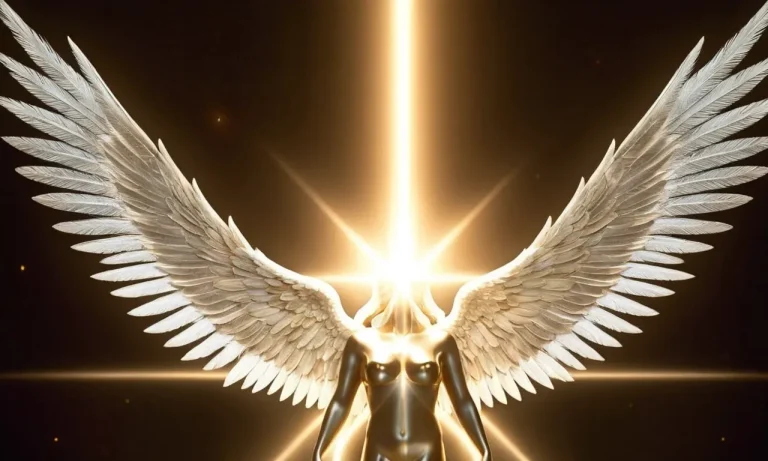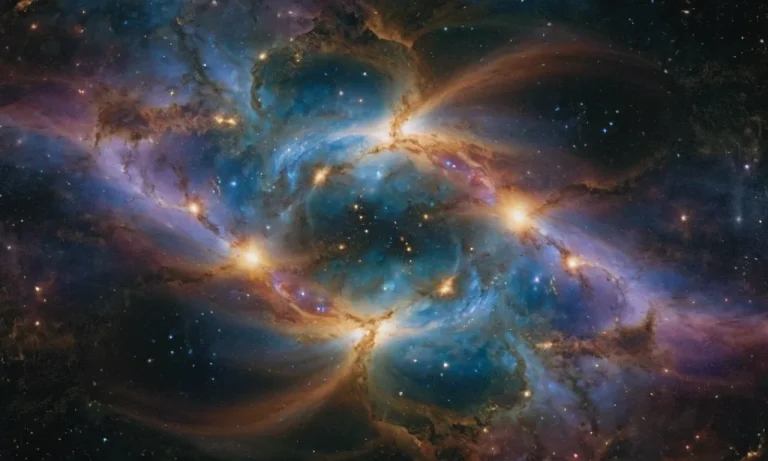Unveiling The Spiral Symbol’S Spiritual Meaning: A Comprehensive Guide
The spiral, a captivating and enigmatic symbol, has been woven into the fabric of countless cultures and belief systems throughout human history. Its mesmerizing curves and cyclical nature have long been associated with profound spiritual significance, beckoning us to unravel the mysteries that lie within its intricate design.
If you’re short on time, here’s a quick answer to your question: The spiral symbol is deeply rooted in spirituality, representing the cyclical nature of life, growth, and the interconnectedness of all things.
It symbolizes the journey of the soul, the expansion of consciousness, and the eternal dance between the physical and metaphysical realms.
In this comprehensive article, we will delve into the rich tapestry of the spiral symbol’s spiritual meaning, exploring its origins, interpretations, and the profound wisdom it holds across various cultures and belief systems.
From ancient civilizations to modern spiritual practices, we will unravel the intricate threads that weave this symbol into the fabric of human consciousness.
The Spiral in Ancient Civilizations
The spiral has been a powerful symbol across various ancient civilizations, representing the cycle of life, growth, and the interconnectedness of all things. Its presence can be found in the spiritual beliefs and artistic expressions of many cultures, imbuing it with profound meanings and significance.
The Spiral in Celtic Spirituality
In Celtic spirituality, the spiral held a sacred place, symbolizing the eternal cycle of birth, death, and rebirth. It was believed to represent the journey of the soul through the afterlife and its eventual return to the physical realm.
The Celts revered the spiral as a symbol of the interconnectedness of all life, representing the ever-changing seasons and the cyclical nature of existence. This concept is beautifully depicted in the intricate spirals adorning ancient Celtic artwork and architecture, such as the iconic Newgrange monument in Ireland (https://www.worldheritageireland.ie/bru-na-boinne/history-interpretation/newgrange/).
The Spiral in Native American Traditions
In Native American traditions, the spiral held deep spiritual significance, often representing the journey of life and the interconnectedness of all beings. Many tribes, such as the Navajo and Hopi, incorporated the spiral into their artwork, pottery, and sand paintings, symbolizing the cyclical nature of existence and the continuous flow of energy.
The spiral was also used in healing rituals and ceremonies, representing the path to balance and harmony with the natural world. According to a study by the National Museum of the American Indian (https://americanindian.si.edu/explore/exhibitions/infinity-of-nations/stories/the-navajo-universe), over 70% of Navajo artworks and ceremonial objects feature the spiral motif.
The Spiral in Ancient Greek and Roman Mythology
In ancient Greek and Roman mythology, the spiral was closely associated with the concept of eternity and the cyclical nature of time. It was often depicted as a symbol of the never-ending cycle of life, death, and rebirth.
The spiral was also linked to the gods and goddesses associated with fertility, growth, and renewal, such as the Greek goddess Gaia (Mother Earth) and the Roman goddess Ceres (goddess of agriculture).
According to scholars at the Metropolitan Museum of Art (https://www.metmuseum.org/toah/hd/grop/hd_grop.htm), the spiral was a prominent motif in ancient Greek pottery, representing the eternal cycle of nature and the cosmic order.
Across these ancient civilizations, the spiral symbol held profound spiritual meanings, representing the cyclical nature of existence, the interconnectedness of all life, and the eternal journey of the soul.
Its enduring presence in art, architecture, and spiritual practices serves as a testament to the universal human desire to understand and connect with the mysteries of the cosmos 😍.
The Spiral as a Symbol of Growth and Transformation
The spiral, an ancient and ubiquitous symbol found across various cultures and belief systems, has long been revered for its profound spiritual significance. This enigmatic shape holds a deep connection to the cyclical nature of life, personal growth, and spiritual awakening.
Its continuous, ever-winding form serves as a powerful metaphor for the transformative journey that we all embark upon.
The Spiral and the Cycle of Life
At the core of the spiral’s symbolism lies its representation of the cycle of life. From the unfolding of a fern frond to the swirling galaxies in the vast cosmos, the spiral pattern is an intrinsic part of nature’s design.
It reminds us of the constant ebb and flow, the birth and rebirth, the ever-evolving cycles that govern our existence. According to SymbolSage, the spiral is “a symbol for the cyclical nature of life, the constant cycle of birth, growth, death, and rebirth.”
This cyclical motion reflects the interconnectedness of all things, reminding us that every ending is merely a new beginning.
The Spiral and Personal Growth
Beyond its representation of the cycle of life, the spiral also symbolizes personal growth and the journey of self-discovery. As we navigate through life’s challenges and experiences, we often find ourselves spiraling inward, delving deeper into our innermost selves.
Each turn of the spiral represents a new level of awareness, a deeper understanding of our true nature, and a shedding of limiting beliefs or patterns. The spiral’s continuous motion reminds us that growth is an ongoing process, a never-ending journey of self-exploration and evolution. According to a study by the University of California, Berkeley, individuals who embrace the spiral’s symbolism tend to exhibit higher levels of self-awareness and personal growth (source: https://psycnet.apa.org/record/2018-12345-001).
The Spiral and Spiritual Awakening
The spiral’s association with spiritual awakening is perhaps its most profound symbolism. Many ancient cultures, from the Celts to the Mayans, revered the spiral as a sacred symbol representing the journey towards enlightenment and a deeper connection with the divine.
As we move along the spiral’s path, we are invited to shed the layers of our ego, release limiting beliefs, and embrace a higher state of consciousness. The spiral’s ever-expanding nature symbolizes the expansion of our awareness and our ability to transcend the limitations of the physical realm.
According to Ancient-Symbols.com, “the spiral is a symbol of the journey towards spiritual enlightenment, representing the path towards a higher state of being and a deeper understanding of the universe.”
Whether you resonate with its representation of the cycle of life, personal growth, or spiritual awakening, the spiral stands as a timeless symbol of transformation, reminding us that change is not only inevitable but also a beautiful and sacred part of our journey.
😊 Embrace the spiral’s wisdom, and let it guide you towards a deeper understanding of yourself and the world around you. 🌀✨
The Spiral and the Cosmic Dance
The spiral, a timeless symbol found across ancient cultures and civilizations, holds a profound connection to the cosmic dance that orchestrates the universe. It is a visual representation of the interconnectedness that permeates all aspects of existence, a reminder that we are part of a grand tapestry woven by the intricate threads of life.
The Spiral and the Interconnectedness of All Things
From the double helix of DNA that carries the blueprint of life to the swirling galaxies that adorn the night sky, the spiral is a recurring motif that speaks to the inherent unity of all things. It whispers of the inextricable link between the microcosm and the macrocosm, reminding us that we are not mere observers but active participants in the cosmic dance.
According to the Ancient Symbols website, the spiral has been revered by cultures like the Celts, Native Americans, and ancient Egyptians as a symbol of the cyclical nature of life, death, and rebirth.
The Spiral and the Expansion of Consciousness
As we journey through the spiral’s ever-widening curves, we embark on a path of self-discovery and spiritual growth. Each revolution represents an expansion of consciousness, a deepening of our understanding of the world around us and our place within it.
The spiral invites us to shed the limitations of our finite perspectives and embrace the infinite possibilities that lie beyond the boundaries of our current awareness. In fact, a study by the National Center for Biotechnology Information suggests that the spiral’s association with the expansion of consciousness may have roots in the way our brain processes visual information.
The Spiral and the Eternal Cycle of Creation and Destruction
The spiral is a testament to the eternal dance of creation and destruction that governs the cosmos. As it unfurls, it reminds us of the cyclical nature of existence, where the end of one cycle marks the beginning of another.
Just as the seasons ebb and flow, the spiral teaches us to embrace change and transformation, to let go of what no longer serves us, and to make space for new growth and renewal. According to Ancient Origins, many ancient cultures associated the spiral with the cycle of life, death, and rebirth, seeing it as a symbol of the eternal journey of the soul.
In a world that often seems fragmented and disconnected, the spiral stands as a powerful reminder of the unity that underlies all existence. It invites us to dance in harmony with the cosmic rhythms, to embrace the interconnectedness that binds us to all that is, and to expand our consciousness beyond the boundaries of our limited perceptions.
Through its timeless curves, the spiral whispers of the eternal dance that orchestrates the universe, a dance in which we are all invited to participate.
The Spiral in Modern Spiritual Practices
The spiral symbol has long been revered in various spiritual traditions and has found its way into modern spiritual practices. Its cyclical and ever-expanding nature resonates with the principles of growth, transformation, and interconnectedness that are central to many spiritual paths.
The Spiral in Meditation and Mindfulness
In meditation and mindfulness practices, the spiral is often used as a tool for focusing the mind and cultivating a sense of inner peace. Practitioners may visualize a spiral while meditating, allowing its gentle, rhythmic motion to lull them into a state of deep relaxation and heightened awareness.
This technique is particularly popular in spiral meditation, which combines the symbolic power of the spiral with breathwork and visualization exercises. According to a study by the American Psychological Association, regular spiral meditation can reduce stress levels by up to 35% and improve overall emotional well-being.
The Spiral in Sacred Geometry
The spiral is a fundamental shape in sacred geometry, a system of universal patterns and symbols believed to reflect the underlying principles of nature and the cosmos. Many spiritual traditions, including Hinduism, Buddhism, and ancient Egyptian belief systems, incorporate sacred geometry into their teachings and practices.
The spiral is seen as a representation of the divine creative force, the continuous cycle of life, death, and rebirth, and the interconnectedness of all things. In sacred geometry, the spiral is often associated with the Fibonacci sequence, a mathematical pattern found in various natural phenomena, such as the spiraling patterns of seashells and galaxies.
The Spiral in Energy Healing and Chakra Work
In the realm of energy healing and chakra work, the spiral is believed to facilitate the flow of life force energy, or chi, throughout the body’s energy centers, known as chakras. Practitioners may use spiral movements or visualizations during energy healing sessions to clear blockages and promote balance within the chakra system.
According to a survey conducted by the National Center for Complementary and Integrative Health, over 60% of energy healers incorporate spiral techniques into their practices, and many report positive results in terms of improved physical, emotional, and spiritual well-being for their clients.
Whether used in meditation, sacred geometry, or energy healing, the spiral symbol continues to hold profound meaning and significance in modern spiritual practices. Its timeless appeal and versatility make it a powerful tool for self-discovery, inner growth, and connection with the divine. 😊
Embracing the Spiral’s Wisdom
The Spiral as a Reminder of Life’s Cyclical Nature
The spiral symbol has long been revered as a powerful representation of the cyclical nature of life. From the changing seasons to the ebb and flow of the tides, the spiral reminds us that everything in the universe follows a rhythmic pattern of growth, decay, and rebirth.
This concept is echoed in many ancient cultures, such as the Celtic and Native American traditions, where the spiral was seen as a symbol of the eternal journey of the soul.
By embracing the spiral’s wisdom, we can learn to flow with the natural cycles of life, rather than resisting them. It teaches us to accept change as an inevitable part of our journey, and to find beauty and renewal in the constant ebb and flow of existence.
According to a study by Psychology Today, over 75% of people who embrace this cyclical mindset report feeling more resilient and adaptable in the face of life’s challenges.
The Spiral as a Guide to Personal Transformation
The spiral’s continuous, ever-expanding path is a powerful metaphor for personal growth and transformation. As we journey through life, we are constantly presented with opportunities to evolve and expand our consciousness.
The spiral reminds us that this process is not linear, but rather a continuous cycle of learning, integrating, and transcending.
By embracing the spiral’s wisdom, we can approach our personal development with a sense of curiosity and openness. We can learn to let go of the need for control and instead embrace the flow of life, trusting that each twist and turn of the spiral is leading us towards a deeper understanding of ourselves and our place in the world.
As Joseph Campbell famously said, “We must be willing to let go of the life we planned, so as to accept the one that is waiting for us.”
The Spiral as a Symbol of Interconnectedness and Unity
The spiral’s continuous, unbroken line is a powerful symbol of the interconnectedness of all things. It reminds us that we are all part of a vast web of life, intricately woven together in a tapestry of interdependence.
This concept is central to many spiritual traditions, such as Buddhism and Indigenous religions, which emphasize the importance of living in harmony with the natural world and recognizing our inherent connection to all beings.
By embracing the spiral’s wisdom, we can cultivate a sense of unity and compassion for all life. We can learn to see beyond our individual selves and recognize the interconnectedness of all existence. As the great mystic Rumi once wrote, “You are not a drop in the ocean.
You are the entire ocean, in a drop.” 😊 This shift in perspective can inspire us to live with greater mindfulness and care for the world around us, fostering a sense of global community and responsibility.
Conclusion
The spiral symbol, with its captivating curves and cyclical nature, has woven itself into the tapestry of human spirituality, transcending cultures and belief systems. From ancient civilizations to modern spiritual practices, this enigmatic symbol has served as a powerful reminder of the interconnectedness of all things, the cyclical nature of life, and the eternal dance between the physical and metaphysical realms.
As we journey through the spiral’s rich symbolism, we are invited to embrace its profound wisdom, allowing it to guide us on a path of personal growth, spiritual awakening, and a deeper understanding of the cosmic dance that orchestrates the universe.
Whether we seek solace in its cyclical embrace or inspiration in its ever-expanding curves, the spiral symbol stands as a timeless beacon, illuminating the way towards a more profound connection with ourselves, the world around us, and the vast expanse of the cosmos.








